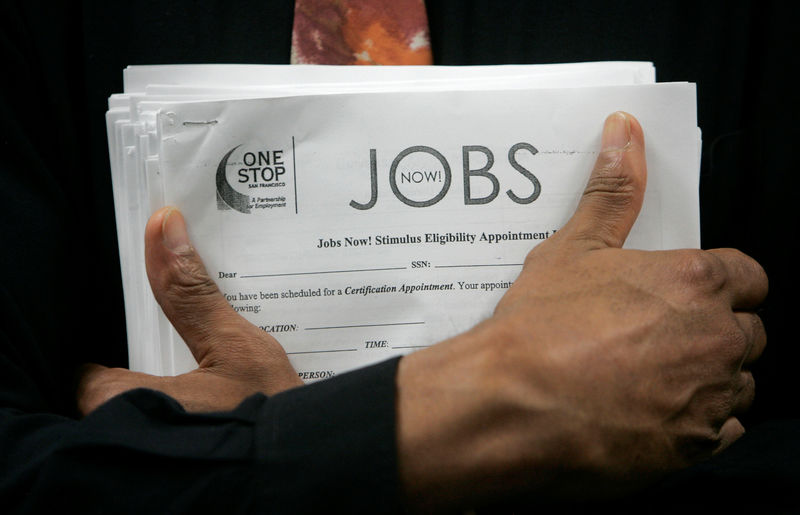By Lucia Mutikani
WASHINGTON (Reuters) - The number of Americans filing for unemployment benefits unexpectedly fell last week, pointing to a further tightening in labor market conditions.
The robust labor market and firming inflation have cemented expectations the Federal Reserve will raise benchmark U.S. interest rates next week. Many economists believe the U.S. central bank will hike rates two more times after its June 12-13 policy meeting to prevent the economy from overheating.
The Fed lifted borrowing costs in March and forecast at least two more rate increases for this year.
"The labor market is heating up and that means inflation pressures are building, so the Federal Reserve better get ready for it," said Chris Rupkey, chief U.S. economist at MUFG in New York. "Rates are going up at next week's meeting and more are on the way."
Initial claims for state unemployment benefits fell 1,000 to a seasonally adjusted 222,000 for the week ended June 2, the Labor Department said on Thursday. Economists polled by Reuters had forecast claims rising to 225,000 in the latest week.
The four-week moving average of initial claims, viewed as a better measure of labor market trends as it irons out week-to-week volatility, rose 2,750 to 225,500 last week.
The dollar was trading lower against a basket of currencies. Prices for longer-dated U.S. Treasuries rose marginally and stocks on Wall Street were mixed.
The labor market is considered to be close to or at full employment. Nonfarm payrolls increased by 223,000 jobs in May and the unemployment rate dropped to an 18-year low of 3.8 percent.
The jobless rate, which has declined by three-tenths of a percentage point this year, is now at a level where the Fed projected it would be by the end of this year.
The number of people receiving benefits after an initial week of aid increased 21,000 to 1.74 million in the week ended May 26. The four-week moving average of so-called continuing claims dropped 13,250 to 1.73 million, the lowest since December 1973.
WORKER SHORTAGE
Layoffs have remained very low amid signs of growing worker shortages across all sectors of the economy. Data on Tuesday showed there were a record 6.7 million job openings in April. The number of unemployed people per vacancy slipped to 0.9 from 1.0 in March.
Economists expect the shrinking pool of unemployed workers will result in an acceleration in wage growth as companies are forced to raise compensation to attract and retain labor. Annual wage growth has remained below 3.0 percent.
"As the unemployment rate inches lower, businesses will find it increasingly difficult to fill open positions," said Maria Cosma, an economist at Moody's Analytics in West Chester, Pennsylvania.
The strong job market conditions were also underscored by the publication on Thursday of the Labor Department's Contingent and Alternative Employment Arrangements survey, which showed 1.3 percent of U.S. workers in May 2017 held jobs they considered temporary or did not expect to last beyond a year.
That is a decline from 1.8 percent in February 2005 when the government last conducted a similar survey.
When self-employed individuals and independent contractors were included, the share of workers was 1.6 percent in May 2017, down from 2.3 percent in February 2005. Most contingent workers were under the age of 25.
"This should throw some cold water on those hyping the explosion of freelancing and the rapidly changing nature of work," said Lawrence Mishel, a fellow at Economic Policy Institute in Washington.
But others said the survey's findings contradicted independent research and faulted the government's methodology, which used the same measurements as 13 years ago to gather data. The last time that the government conducted the survey was before the invention of smartphones.
"This data is saying that the percentage of workers in contingent or alternative work arrangements has either stayed the same or declined since the advent of smartphones," said Cathy Barrera, chief economist at ZipRecruiter. "The labor market has changed a great deal, not only over the last 13 years, but over the last generation."

The Labor Department will publish its Contingent Worker Supplement report in September. It is expected to shed light on the so-called gig economy.